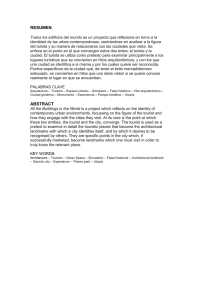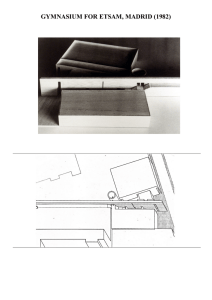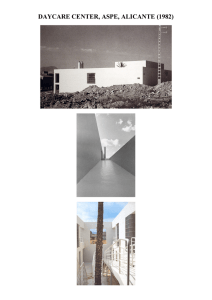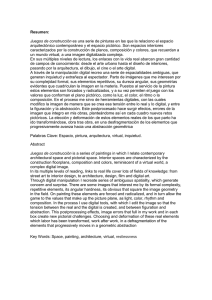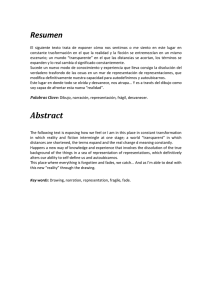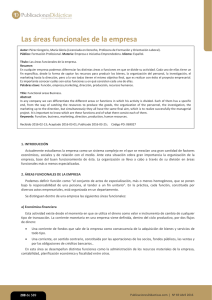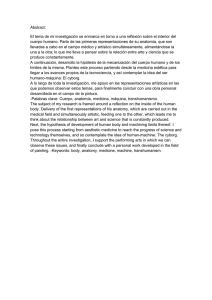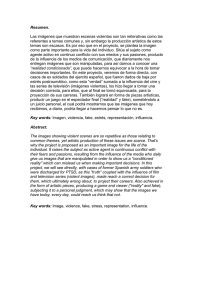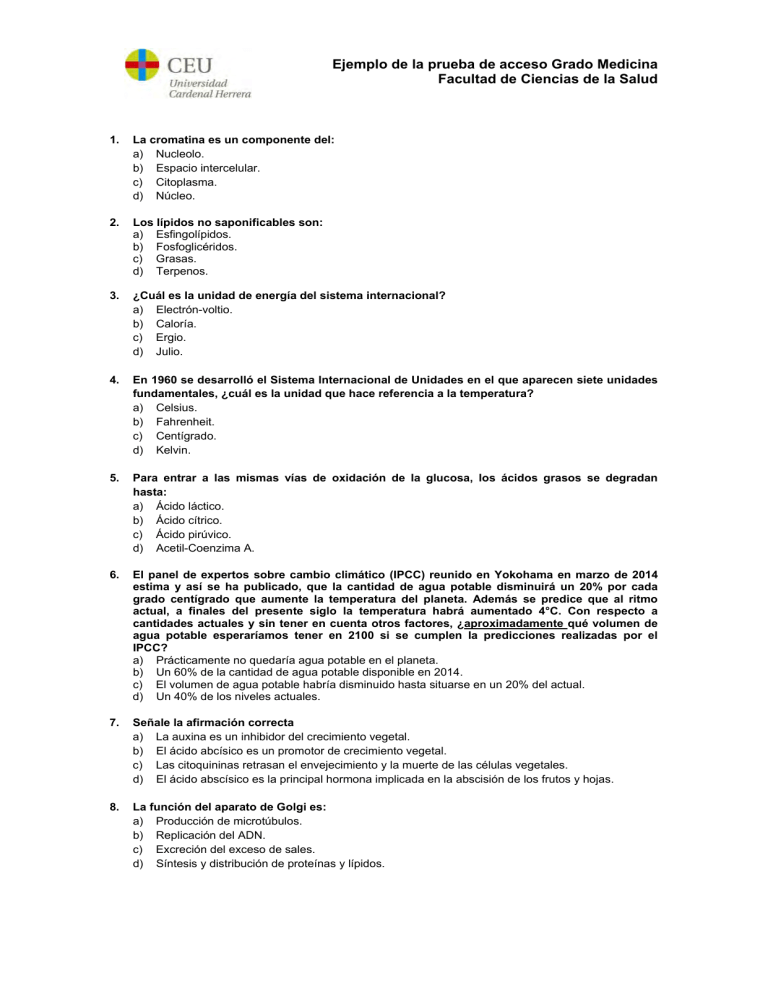
Ejemplo de la prueba de acceso Grado Medicina Facultad de Ciencias de la Salud 1. La cromatina es un componente del: a) Nucleolo. b) Espacio intercelular. c) Citoplasma. d) Núcleo. 2. Los Iípidos no saponificables son: a) Esfingolípidos. b) Fosfoglicéridos. c) Grasas. d) Terpenos. 3. ¿Cuál es la unidad de energía del sistema internacional? a) Electrón-voltio. b) Caloría. c) Ergio. d) Julio. 4. En 1960 se desarrolló el Sistema Internacional de Unidades en el que aparecen siete unidades fundamentales, ¿cuál es la unidad que hace referencia a la temperatura? a) Celsius. b) Fahrenheit. c) Centígrado. d) Kelvin. 5. Para entrar a las mismas vías de oxidación de la glucosa, los ácidos grasos se degradan hasta: a) Ácido láctico. b) Ácido cítrico. c) Ácido pirúvico. d) Acetil-Coenzima A. 6. El panel de expertos sobre cambio climático (IPCC) reunido en Yokohama en marzo de 2014 estima y así se ha publicado, que la cantidad de agua potable disminuirá un 20% por cada grado centígrado que aumente la temperatura del planeta. Además se predice que al ritmo actual, a finales del presente siglo la temperatura habrá aumentado 4°C. Con respecto a cantidades actuales y sin tener en cuenta otros factores, ¿aproximadamente qué volumen de agua potable esperaríamos tener en 2100 si se cumplen la predicciones realizadas por el IPCC? a) Prácticamente no quedaría agua potable en el planeta. b) Un 60% de la cantidad de agua potable disponible en 2014. c) El volumen de agua potable habría disminuido hasta situarse en un 20% del actual. d) Un 40% de los niveles actuales. 7. Señale la afirmación correcta a) La auxina es un inhibidor del crecimiento vegetal. b) El ácido abcísico es un promotor de crecimiento vegetal. c) Las citoquininas retrasan el envejecimiento y la muerte de las células vegetales. d) El ácido abscísico es la principal hormona implicada en la abscisión de los frutos y hojas. 8. La función del aparato de Golgi es: a) Producción de microtúbulos. b) Replicación del ADN. c) Excreción del exceso de sales. d) Síntesis y distribución de proteínas y lípidos. Ejemplo de la prueba de acceso Grado Medicina Facultad de Ciencias de la Salud 9. ¿Cuál de las siguientes unidades no es una unidad fundamental del Sistema Internacional de Unidades? a) Kilogramo (kg). b) Kelvin (K). c) Mol (mol). d) Julio (J). 10. La replicación del ADN incluye los siguientes acontecimientos EXCEPTO: a) Replicación conservando una hebra vieja y sintetizando una nueva. b) Se separan las dos hebras por medio de la enzima helicasa. c) Replicación por medio de la enzima ADN polimerasa. d) Desempaquetamiento de los cromosomas. 11. ¿Cómo mediría 4 litros con una garrafa de 3 litros y otra de 5 litros? a) No se puede hacer. b) Llenar la garrafa de 5 litros y pasarlos a la de tres. Vaciar la de tres y adicionar los dos restantes. Llenar la de 5 y adicionar 1 litro a la de tres. c) Llenar la garrafa de 3 litros y trasvasarlos a la de 5 litros. Llenar de nuevo la garrafa de tres litros y completar la de cinco litros. Vaciar la garrafa de 5 litros y trasvasar a esta última el contenido de la de 3 litros. Llenar de nuevo la garrafa de 3 litros y verter su contenido en la de 5 litros. d) Cualquiera de las opciones b ó c. 12. ¿Qué es una molécula bipolar?: a) Aquella que tiene una región polar o hidrófoba, y otra apolar o hidrófila. b) Aquella que tiene una región apolar o afín al agua, y otra polar o hidrófoba. c) Aquella que tiene una región polar o hidrófila, y otra apolar o afín al agua. d) Aquella que tiene una región polar o afín al agua, y otra apolar o hidrófoba. 13. ¿Para qué valor o valores dados de x se cumple que x2 < 16 y 2x + 5 ≥ 9? a) x < -4 y x ≥ 2. b) x < 4. c) x ≥ 2. d) 2 ≤ x<4. 14. Los flagelos de los procariotas están constituidos por: a) Microtúbulos proteicos de tubulina. b) Los procariotas no tienen flagelos. c) Su estructura depende de las especies. d) Una proteína llamada flagelina. 15. El orden correcto de eventos en la mitosis es: a) Anafase; Profase; Metafase; Telofase. b) Profase; Anafase; Metafase; Telofase. c) Profase; Anafase; Telofase; Metafase. d) Profase; Metafase; Anafase; Telofase. 16. Imagine que tiene que rotular las sillas de su clase con números del 1 al 100. ¿Cuántas veces rotulará el número nueve? a) Diez. b) Once. c) Diez y nueve. d) Veinte. 17. Cuando los niveles de glucosa en sangre son muy altos, el páncreas segrega: a) Glucagón. b) Tripsina. c) Adrenalina. d) Insulina. Ejemplo de la prueba de acceso Grado Medicina Facultad de Ciencias de la Salud 18. Si alguien realiza un daño sobre un objeto propiedad de otra persona, lo correcto es realizar una compensación. Esto se denomina restitución ¿Cuál de las siguientes situaciones sería el mejor ejemplo de restitución? a) El vecino de Rebeca le deja su coche y cuando ella se lo devuelve, el depósito está prácticamente vacío. Rebeca le pide disculpas y le dice que no volverá a ocurrir. b) Aarón le pide a Tomás que vigile su apartamento mientras el está de viaje. Cuando Tomás regresa descubre que se ha roto una cañería, que ha producido un daño considerable. El fontanero repara la cañeríay Tomás le pasa la factura de la reparación a Aarón. c) Lisa sospecha que un bache en el aparcamiento de su empresa le ha producido un pichazo en la rueda de su coche. Lisa le dice a su jefe que cree que la empresa debería restituirle la rueda. d) Ana le presta su cámara a Juan y la lente se rompe cuando a Juan se le cae la cámara al suelo al no cerrar la funda correctamente. Cuando Juan devuelve la cámara le dice a Ana que él asumirá los gastos de la reparación. 19. Un paciente tiene anemia de células falciformes por una mutación puntual en su ADN que cambia el sexto aminoácido en la cadena de la globina β de la hemoglobina, de glutamato (COOH, en su cadena lateral) a valina (-CH(CH3)2 en su cadena lateral). ¿Qué diferencia puede esperarse en los enlaces químicos formados por este nuevo aminoácido? a) Tendrán carga positiva. b) Tendrán carga negativa. c) Dará lugar a la formación de interacciones hidrofílicas. d) Dará lugar a la formación de interacciones hidrofóbicas. 20. ¿De cuál de los siguientes está compuesta la columna central de una cadena de ADN? a) Bases y fosfatos. b) Nucleótidos y azúcares. c) Fosfatos y nucleósidos. d) Fosfatos y azúcares. 21. Las reglas de Chargaff en un ADN típico dicen que la relación purinas (A, G)/pirimidinas (T,C) se aproximan a la unidad. ¿Cuál de las siguientes representa dicha regla? a) T=G. b) A=C. c) A+T=G+C. d) A+G=T+C. 22. Hay datos que demuestran que los habitantes de Groenlandia obtuvieron puntuaciones más altas en cuestionarios de felicidad que los habitantes de México. ¿Cuál de las siguientes es la mejor conclusión que podemos extraer de estos datos? a) Todas las personas que viven en los países fríos son más felices que las que viven en países más cálidos. b) En Groenlandia solo vive gente feliz. c) Los mexicanos serían más felices si se trasladasen a Groenlandia. d) A los groenlandeses que obtuvieron puntuaciones altas en los cuestionarios de felicidad probablemente les guste la nieve. 23. El pH de la sangre arterial es aproximadamente 7.4. ¿Cuál de los siguientes representa al pH de sangre venosa? a) 7.47. b) 7.00. c) 4.35. d) 7.33. 24. Si en el código genético cada tres residuos nucleotídicos del ADN codifican un aminoácido, ¿cuántas combinaciones diferentes son posibles? a) 20. b) 128. c) 32. d) 64. Ejemplo de la prueba de acceso Grado Medicina Facultad de Ciencias de la Salud 25. Un padre del grupo sanguíneo A y una madre cuyo grupo sanguíneo es AB (genotipo codominante: IAIB) tienen tres hijos: un varón del grupo A, otro varón del grupo AB y una hija del grupo B. La descendencia de esta hija con un hombre del grupo sanguíneo O (genotipo recesivo: ii) está formada por dos hijas de grupos sanguíneos diferentes. Una de las hijas (individuo 7 en el diagrama) tiene sangre del grupo O. ¿Cuál es el grupo sanguíneo de la otra hija (individuo 8 en el diagrama)? a) b) c) d) O. AB A. B. 26. Si una toxina bacteriana tiene como diana a los ribosomas, ¿qué función celular se verá afectada en primer lugar? a) Almacenaje de energía. b) Síntesis de ADN. c) Motilidad celular. d) Síntesis proteica. 27. La representación vectorial de la velocidad angular del minutero de un reloj es: a) Un vector axial perpendicular al plano del reloj y de módulo /3600 rad/s. b) Un vector representado por la propia manecilla del minutero y de módulo /60. c) Un vector axial perpendicular al plano del reloj y de módulo /60 rad/s. d) Un vector axial perpendicular al plano del reloj y de módulo /1800 rad/s. 28. ¿Cuál de las siguientes magnitudes no es vectorial? a) Peso. b) Velocidad. c) Fuerza. d) Masa. 29. El índice de refracción de un vidrio es de 1.5. Determine la velocidad de la luz en su interior. a) 340 m/s. b) 340 km/h. c) 3·108 m/s. d) 2·108 m/s. 30. La Molaridad se define como: a) Moles de soluto/moles de disolución. b) Moles de disolución/litros de disolvente. c) Moles de disolución/kilogramos de disolución. d) Moles de soluto/litros de disolución. Ejemplo de la prueba de acceso Grado Medicina Facultad de Ciencias de la Salud 31. El grupo cuyos elementos tienen las energías de ionización más bajas es el de los: a) Halógenos. b) Todos tienen energías de ionización similares. c) Lantánidos. d) Metales alcalinos. 32. Tienes que pesar 155 mg de bicarbonato sódico para un experimento de fotosíntesis. Tu balanza muestra el peso solo en gramos. ¿Cuántos gramos de bicarbonato sódico tienes que pesar? a) 155 g. b) 15.5 g. . c) 1.55 g. d) 0.155 g 33. ¿Con qué inclinación debe dispararse un proyectil desde el suelo para conseguir mayor alcance? a) 60º. b) 90º. c) 30º. d) 45º. 34. Al fenómeno que permite que insectos como el zapatero (Hydrometra stagnorum) se desplacen a gran velocidad sobre el agua sin hundirse, se le denomina: a) Viscosidad. b) Fuerza de repulsión. c) Empuje. d) Tensión superficial. 35. “Un medicamento se presenta en un frasco que contiene 750 mg del fármaco liofilizado”. Liofilización significa que: a) El fármaco está en forma sólida, tras evaporar el agua mediante calor seco a una temperatura que no destruye el contenido. b) El agua que contenía el medicamento ha sido evaporada disolviéndola en alcohol y calentando la solución a muy baja temperatura. c) Se ha eliminado el agua por evaporación llevando el líquido a ebullición en ausencia de aire (en vacío). d) El agua se congela previamente y se reduce la presión para sublimarla directamente desde la fase sólida a la fase gaseosa. 36. En la siguiente serie: 58, 52, 46, 40, 34, …¿qué número sería el siguiente? a) 26. b) 30. c) 32. d) 28. 37. ¿Qué tipo de moléculas se separan mejor por electroforesis? a) Las grandes. b) Las que no tienen carga eléctrica. c) Las pequeñas. d) Las que tienen carga eléctrica. 38. El pasado viernes 4 de Abril de 2014 Juan cumplió 40 años. ¿Cuántos años tendrá Juan la próxima vez que su cumpleaños se celebre en viernes? a) 53. b) 46. c) 47. d) 51. Ejemplo de la prueba de acceso Grado Medicina Facultad de Ciencias de la Salud 39. “Uno de los factores de la desnutrición infantil, es la falta de una política de producción alimentaria en los países en desarrollo. Puesto que quieren exportar todos los alimentos que producen, estos países dejan de cubrir las necesidades de la población. Hace falta una vigilancia obligatoria del Gobierno sobre la alimentación infantil, proveyéndola de todos los nutrientes indispensables para el normal desarrollo y crecimiento de los niños, al menos hasta que ellos mismos puedan procurárselos. La desnutrición infantil degenera en todo tipo de defectos, malformaciones físicas y psíquicas, puede originar serios problemas mentales, y niños resentidos e inadaptados. Asia, África y América Latina, son los principales focos de la malnutrición, y con una mayor incidencia en la niñez. Sirva decir, que el tercer mundo carece de una política alimentaria acorde con el crecimiento de su población. Los países subdesarrollados producen especialmente materias primas exportables, llegando al extremo de tener que importar la mayor parte de los alimentos que consumen y que antes producían.” Señale el esquema temático del texto: a) La desnutrición y el Gobierno. b) Los países del tercer mundo y la desnutrición. c) Los factores de la desnutrición infantil y sus consecuencias. d) Los países subdesarrollados, la desnutrición infantil y la exportación. 40. Dada la ecuación: a) x= b) x= c) x= d) x= , ¿cuál de los siguientes sería un valor correcto de x? 41. Julia, Jacinta, Juan y Jaime viven en cuatro casas contiguas en la misma calle. Julia y Jacinta viven en casas colindantes, pero la casa de Julia no es contigua a la de Juan. La casa de Jaime no está al lado de la de Juan. ¿Quién vive en la casa colindante con la de Jaime? a) Jacinta. b) Juan. c) Jerónimo. d) Julia. 42. De los siguientes elementos, ¿cuál de ellos es el más abundante en el Universo? a) Helio. b) Carbono. c) Oxígeno. d) Hidrógeno. 43. ¿Qué es la polifonía? a) La capacidad del ser humano y algunos animales de emitir varios sonidos simultáneamente. b) El típico sonido de la sirena de los coches de policía (y ambulancias). c) El ruido característico de las grandes ciudades. d) Voces melódicas múltiples que suenan simultáneamente en una obra musical. Ejemplo de la prueba de acceso Grado Medicina Facultad de Ciencias de la Salud 44. Muchas personas prefieren llevar una tarjeta de crédito en su cartera en lugar de billetes y monedas para pagar por sus compras. Sin embargo, la utilización de tarjetas de crédito lleva aparejado un incremento en los costes de aquello que compramos, puesto que los bancos emisores de las tarjetas cobran a los negocios entre un 1 y un 3% del valor de la transacción. Los comercios hacen frente a este sobrecoste incrementando el precio de los productos que venden, de manera que al final es el consumidor quien acaba pagando más por lo que compra, independientemente de si paga con tarjeta de crédito o en efectivo. ¿Cuál de las siguientes afirmaciones resume mejor el contenido de este párrafo? a) Es más cómodo llevar una tarjeta de crédito que dinero en efectivo a pesar del incremento en los costes. b) Los comercios se defienden de las prácticas abusivas de los bancos trasladando al consumidor sus tasas bancarias por el uso de tarjetas. c) Si todos dejásemos de usar tarjetas de plástico para pagar en los comercios, los precios descenderían entre un 1 y un 3%. d) Los principales beneficiados por el uso de tarjetas de crédito son los bancos, mientras que consumidores y comerciantes pagan por su uso. 45. ¿Cuál de las siguientes opciones NO presenta un razonamiento válido? a) A nadie de los que comen en la cafetería le gustan las lentejas. El director de la empresa come en la cafetería. Por lo tanto al director no le gustan las lentejas. b) En la despensa de Carlos hay seis latas de alubias y en su sótano tiene almacenadas otras catorce. En su casa no hay más latas de alubias. Por tanto, Carlos tiene en su casa 20 latas de alubias. c) Las personas al norte de la autopista M3 llegaron tarde al trabajo. Julio estaba al norte de la M3. Julio llegó tarde al trabajo. d) Mohamed vive en Valencia (Comunidad Valenciana), en Valencia de Don Juan (Castilla León) o en Valencia de Alcántara (Extremadura). Si vive en cualquiera de estas Valencias, Mohamed es español. 46. Mila no ha asistido hoy a clase debido al dolor muscular que ella achaca al exceso de ejercicio físico que realizó ayer. Si Mila tiene razón, el dolor que sufre es probablemente debido a: a) La formación de ácido pirúvico. b) La formación de ácido clorhídrico. c) La formación de ácido acético. d) La formación de ácido láctico. 47. Para realizar ajustes en la economía del país el gobierno de Bubblein decidió reducir el salario de sus funcionarios un 5% en 2011 y otro 5% en 2012. Tras muchas presiones y negociaciones el gobierno ha decidido que restituirá los sueldos de los funcionarios a los valores que tenían antes de que se realizasen los ajustes. Redondeando, ¿cuál es el incremento porcentual que tendría que realizarse sobre el salario de los funcionarios para restituirlos a niveles anteriores a 2011? a) 7.5%. b) 10%. c) 25%. d) 11%. 48. ¿Cuál de las siguientes afirmaciones describe el modelo de mosaico fluido de la membrana plasmatica? a) Tricapa de fosfolipidos con proteinas embebidas. b) Bicapa de trigliceridos con proteinas embebidas. c) Monocapa de fosfolipidos con proteinas embebidas. d) Bicapa de fosfolipidos con proteinas embebidas. Ejemplo de la prueba de acceso Grado Medicina Facultad de Ciencias de la Salud 49. ¿Cuál de las siguientes frases es una opinión? a) Se estima que el 85% de todos los casos de cáncer de pulmón son causados por el humo de los cigarrillos. b) El monte más alto en África es el Kilimanjaro, en Tanzania. c) El mayor océano de la Tierra es el Pacífico; cubre aproximadamente un 30% de la superficie de la Tierra. d) Los perros son mejores mascotas que las tortugas.. 50. Según cifras de la “National Oceanic and Atmospheric Administration” correspondientes al año 2011, los pescadores de caña y carrete capturaron unas 640 toneladas de atún rojo, en contraste con 74 toneladas pescadas con el arte del palangre (arte que usa un hilo con múltiples anzuelos) y 29 toneladas extraídas con arpones. Los palangres dirigidos a otras especies capturaron accidentalmente miles de atunes que después se desecharon, tal vez en número semejante a las 120 toneladas que se descartaron en 2010. En cualquier caso, las capturas con caña y carrete suponen casi el 75 por ciento de todas las capturas de atún rojo en los Estados Unidos. La proporción de pescado que se pesca con caña y carrete es llamativa, sobre todo si tenemos en cuenta que, a diferencia de los pescadores que utilizan redes de cerco, los pescadores de caña capturan los atunes de uno en uno, y los atunes rojos son peces que luchan y se resisten mucho tiempo para evitar que los icen al barco. (tomado de www.nationalgeographic.es). Señale cuál de las siguientes afirmaciones se deduce del texto. a) La pesca con caña y carrete es más eficiente que la pesca con el arte del palangre porque se consiguieron más capturas. b) La pesca con palangre es poco eficiente porque obliga a desechar algunos de los atunes pescados. c) La pesca con caña produce más sufrimiento a los atunes que la pesca con palangre. Hay muchos más pescadores que se dedican a la pesca con caña y carrete que los que lo hacen con el arte del palangre. d) Hay muchos más pescadores que se dedican a la pesca con caña y carrete que los que lo hacen con el arte del palangre. Model test for accessing to the Grado Medicina Health Sciences Faculty 1. Chromatin is a component of the: a) Nucleolus. b) Intracellular space. c) Cytoplasm. d) Nucleus. 2. Non-saponifiable Iipids are: a) Sphingolipids. b) Phosphoglycerides. c) Fats. d) Terpenes. 3. According to the International System of Units, what is the unit for energy? a) Calories. b) Electronvolts. c) Erg. d) Joule. 4. In 1960 the International System of Units was developed containing seven fundamental units. What is the SI unit for temperature? a) Celsius. b) Fahrenheit. c) Centigrade. d) Kelvin. 5. In order to be able to break down fatty acids via the same oxidation pathways as glucose, they must first be converted to: a) Citric acid. b) Lactic acid. c) Pyruvic acid. d) Acetyl-Coenzyme A. 6. At their Yokohama meeting in March 2014, the International Panel on Climate Change (IPCC) revealed that for each degree centigrade that global temperature increases there would be a 20% reduction in the amount of potable water available. At the present rate global temperatures are expected to rise a total of 4°C by the end of the current century. Not taking any other factors into consideration, what is the volume of potable water the world can expect to have in 2100 if these predictions hold? a) The volume of potable water would have been reduced to 20% of today´s values. b) 60% of the amount of potable water available in 2014. c) There would be practically no potable water left in the planet. d) 40% of current levels. 7. Which of the following sentences is correct: a) Auxin is a plant growth inhibitor. b) Cytokinins retard aging and death of plant cells. c) Abscisic acid promotes plant growth. d) Abscisic acid is the main hormone involved in abscission of fruit and leaves. 8. The function of the Golgi apparatus is: a) Microtubule production. b) Excretion of excess salts. c) DNA replication. d) Synthesis and distribution of proteins and lipids. Model test for accessing to the Grado Medicina Health Sciences Faculty 9. Which of the following is not a base unit in the International System of Units? a) Kilogram (kg). b) Kelvin (K). c) Mol (mol). d) Joule (J). 10. The process of DNA replication includes all the following steps EXCEPT: a) Unwinding of the two DNA strands by a helicase. b) Replication by DNA polymerase. c) Maintaining an old strand and synthesizing a new one. d) Unpacking of chromosomes. 11. How could you accurately measure 4 litres if you only possessed one 3 litre carafe and one 5 litre carafe? a) It cannot be measured. b) Fill the 5 litre carafe and from that,fill the 3 litre one. Empty the three litre carafe and fill it with the remaining contents of the 5-litre carafe. Fill the 5 litre carafe and from it fill completely the 3 litre container. c) Fill the 3 litre carafe, and transfer its contents to the 5 litre one. Fill once again the 3 litre carafe, and with its contents, fill the 5-litre one. Empty the 5-litre carafe and add to it the contents of the 3-litre carafe. Once again, fill the 3-litre carafe and empty it into the 5 litre container. d) Options b and c are both correct. 12. Which of the following options best describes a bipolar molecule? a) One which has a region with an affinity to water (polar) and a nonpolar or hydrophobic region. b) One which has a polar or hydrophobic region, and a nonpolar or hydrophilic region c) One which has a non-polar region with an affinity to water and another polar (hydrophobic) region. d) One which has a hydrophilic or polar region, and a nonpolar region with an affinity to water. 13. For which value (or values) of x does the following hold true: x2 < 16 and 2x + 5 ≥ 9? a) x < -4 y x ≥ 2. b) x < 4. c) x ≥ 2. d) 2 ≤ x<4. 14. Prokaryotic flagellae are composed of: a) Prokaryotes do not have flagella. b) Flagellar structure varies from species to species. c) Tubulin microtubules. d) Flagellin protein. 15. In mitosis, the correct order of events is: a) Prophase; Anaphase; Metaphase; Telophase. b) Anaphase; Prophase; Metaphase; Telophase. c) Prophase; Anaphase; Telophase; Metaphase. d) Prophase; Metaphase; Anaphase; Telophase. 16. If you were to number the chairs in your classroom from 1 to 100, how many times would you use the number 9? a) Ten. b) Eleven. c) Nineteen. d) Twenty. Model test for accessing to the Grado Medicina Health Sciences Faculty 17. When blood glucose levels are too high, the pancreas secretes: a) Glucagon. b) Trypsin. c) Adrenalin. d) Insulin. 18. It is appropriate to compensate someone if you have damaged his or her property in some way. This is called Restitution. Which situation below is the best example of Restitution? a) Rebecca borrows her neighbor’s car, and when she returns it, the petrol tank is practically empty. She apologizes profusely and tells her neighbor she will be more considerate the next time. b) Aaron asks Tom to check in on his apartment while he is out of town. When Tom arrives, he discovers that a pipe has burst and there is a considerable amount of water damage. He calls a plumber to repair the pipe. c) Lisa suspects that the pothole in her company’s parking lot caused her flat tire. She tells her boss that she thinks the company should pay for the repair. d) Jake borrows Leslie’s camera and the lens shatters when it falls on the ground because he fails to close the case properly. When Jake returns the camera, he tells Leslie that he will pay for the repair. 19. A patient is diagnosed with Sickle-cell anemia caused by a point mutation in his/her DNA, which changes the sixth amino acid in the globin β gene for hemoglobin which results in glutamic acid ((which carries a -COOH group in its side chain) being substituted by valine (-CH(CH3)2) at position 6. What difference can be expected in the chemical bonds formed by the new amino acid? a) They will be positively charged. b) They will be negatively charged. c) It will create new hydrophilic interactions. d) It will create new hydrophobic interactions. 20. Which of the following make up the DNA backbone ? a) Nucleobases and phosphates. b) Nucleotides and sugars . c) Phosphates and nucleotides. d) Phosphates and sugars. 21. Chargaff´s rules state that for a typical fragment of DNA, the ratio between purines(A, G) and pyrimidines (T,C) is close to 1. Which of the following represents that rule? a) T=G. b) A=C. c) A+T=G+C. d) A+G=T+C. 22. Evidence shows that people who live in Greenland score higher on happiness surveys than those who live in Mexico. Which is the best conclusion that can be drawn from this data? a) Mexicans would be happier if they moved to the Greenland. b) People in colder climates are happier than those in warmer climates. c) There are only happy people in Greenland. d) Those in Greenland who scored high on the happiness surveys probably like snow. 23. If the pH of arterial blood is approximately 7.4, which of the following is most likely to correspond to the pH of venous blood? a) 7.47. b) 7.00. c) 4.35. d) 7.33. 24. According to the rules of the genetic code, each amino acid is encoded by a sequence of three nucleotides. How many combinations of these three nucleotide triplets are possible? a) 20. b) 128. c) 32. d) 64. Model test for accessing to the Grado Medicina Health Sciences Faculty 25. A father has blood type A and a mother has blood type AB (co-dominant genotype: IAIB). They have 3 children, a son with blood type A, another son with blood type AB, and a daughter with blood type B. The daughter then marries a man with blood type O (recessive genotype: ii) and they have two daughters with different blood types. One of the daughters has blood type O. What is the blood type of the other daughter? a) b) c) d) O. AB A. B. 26. If the target of a bacterial toxin are the ribosomes, what cellular function will be affected first? a) Energy storage. b) DNA synthesis. c) Cellular motility. d) Protein synthesis. 27. The representation of the angular velocity of the hands of a clock is: a) An axial vector perpendicular to the plane of the clock and the module /3600 rad/s. b) A vector represented by the minute hand of the clock and the module /60. c) An axial vector perpendicular to the plane of the clock and the module /60 rad/s. d) An axial vector perpendicular to the plane of the clock and the module /1800 rad/s. 28. Which of the following magnitudes is not vectorial? a) Velocity. b) Weight. c) Force. d) Mass. 29. The refractive index of glass is 1.5. Determine the velocity of light inside it. a) 340 m/s. b) 340 km/h. c) 3·108 m/s. d) 2·108 m/s. 30. Molarity is defined as: a) Moles of solute/moles of solution. b) Moles of solution/liters of solvent. c) Moles of solution/kilograms of solution. d) Moles of solute/liters of solution. 31. The group of elements with the lowest ionization energy is: a) The following three options have similar ionization energy. b) Lanthanides. c) Halogens. d) Alkali metals. Model test for accessing to the Grado Medicina Health Sciences Faculty 32. You have to weigh 155 mg of sodium bicarbonate for an experiment on photosynthesis. Your weighing scale shows weight in terms of g (grams) only. How many g of sodium bicarbonate powder do you need to weigh out? a) 155 g. b) 15.5 g. c) 1.55 g. d) 0.155 g. 33. At which angle should you throw a projectile for maximum range? a) 60º. b) 90º. c) 30º. d) 45º. 34. The phenomenon by which the water-walking insect (Hydrometra stagnorum) moves on the surface of water without sinking, relies on : a) Viscosity. b) Repulsive force. c) Pushing power. d) Surface tension. 35. “The medication was available in a vial containing 750 mg of lyophilized drug”. Lyophilization means that …. a) The drug is in solid form after water evaporation by means of dry heat at set temperature. b) Water content in the medication has been evaporated by dissolving it in ethanol and heating it up at low temperature. c) Water has been evaporated by boiling the preparation in absence of air (under vacuum). d) Water has been eliminated by freezing it and then reducing the pressure to sublimate it directly from the solid phase to the gas phase. 36. Look at this series: 58, 52, 46, 40, 34, . . . What number should come next? a) 26 b) 30 c) 32 d) 28 37. Electrophoresis is best used to separate which type of molecules? a) Large molecules. b) Small molecules. c) Non-charged molecules. d) Charged molecules. 38. On Friday the 23rd May, 2014 John will celebrate his 40th birthday. How old will John be the next time his birthday falls again on a Friday? a) 46. b) 53. c) 47. d) 51. Model test for accessing to the Grado Medicina Health Sciences Faculty 39. "One of the factors contributing to child malnutrition is the lack of food production policy in developing countries. Since they want to export all the food they produce, these countries often fail to meet the needs of their population. Thus, to provide children with all the essential nutrients necessary for their normal development and growth, at least until they can obtain them themselves, mandatory surveillance of the Government on child nutrition is needed. Child malnutrition generates many kinds of defects, physical and psychological malformations; it can lead to serious mental health problems, and can result in maladjusted and resentful children. Asia, Africa and South America, are at the heart of malnutrition with the highest incidence during childhood. Suffice to say, that the third world lacks a policy on food in line with the growth of its population. Underdeveloped countries primarily produce exportable products, to such an extent that they have to import most of the food they consume and which they formerly produced." Which of the following options best summarises the above text? a) Malnutrition and the Government. b) Third world countries and malnutrition. c) The factors of child malnutrition and its consequences. d) Undeveloped countries, child malnutrition and export. 40. Given the equation: a) x= b) x= c) x= d) x= , Which of the following is the correct value for x? 41. Julie, Jane, John and James live in a row of houses in the same street. Julie and Jane are next door neighbours but Julie does not live next door to John. James does not live next door to John. Who lives next door to James? a) Jane. b) John c) Jerome. d) Julie. 42. Which of the following elements is found in the greatest abundance in the Universe? a) Helium. b) Carbon. c) Oxygen. d) Hydrogen. 43. What is polyphony? a) The ability of humans (and some animals) to produce several sounds simultaneously. b) It is the typical sound of a police car (and ambulance) siren. c) The characteristic noise of large cities. d) In a musical piece, several melodies that sound simultaneously. Model test for accessing to the Grado Medicina Health Sciences Faculty 44. Many people prefer to carry a credit card than cash to pay for any purchases they make. However usage of credit cards carries an increase in prices for our purchases, since the Banks charge business between 1 and 3% of the total amount in any transaction. Business cover those surcharges made by the Banks by increasing the price of the goods they sell independently of the form of payment the customer chooses, so that in the end is the consumer who ends up paying more for the goods purchased, in benefit of the banks. Which of the following options best summarise the paragraph above? a) If everyone stopped using plastic cards to pay for the goods we buy prices would fall between 1 and 3%. b) It is more convenient to carry a credit card that cash in spite of the increase in costs. c) Businesses defend themselves from the abusive bank practices by passing their bank charges onto the consumers. d) Banks are the only beneficiaries of credit card use, whereas customers and shops pay for their use. 45. Which of the following statements is NOT a valid argument? a) There are six cans of beans in Carlo's pantry and 14 in his basement. There are no other cans of beans in his house. Therefore, he has 20 cans of beans in his house. b) Everyone northbound on the motorway M3 was late for work. Jason was northbound on the M3. Jason was late for work. c) No one who eats in the cafeteria likes lentil soup. The chief executive of the company eats in the cafeteria. Therefore, he does not like lentil soup. d) Huang lives in either Kansas (State), Kansas City (Kansas), or Kansas City (Missouri). Huang is an American. 46. Mila has not come to class today because she has pain and stiffness in her muscles which she thinks is linked to her excess of physical exercise yesterday. If Mila’s assumption is correct,the most probable cause of the muscle pain is: a) Pyruvic acid build up. b) Accumulation of hydrochloric acid. c) Acetic acid build up. d) Accumulation of lactic acid. 47. In order to make some economic adjustments the government of Bubblein decided to reduce the salary of civil servants by 5% in 2011 and a further 5% in 2012. After much pressure and lobbying the government agreed to restore civil servants salaries to what they use to be before the cuts. By what percentage should the salaries be increased in 2014 so that they reach the original pre-cut levels? a) 10%. b) 25%. c) 7.5%. d) 11%. 48. Which of the following describes the fluid-mosaic model of the plasma membrane structure? a) Phospholipid trilayer with embedded proteins. d) Triglyceride bilayer with embedded proteins. c) Phospholipid monolayer with embedded proteins. b) Phospholipid bilayer with embedded proteins. 49. Which of the following four sentences is an opinion rather than a fact? a) Eighty-five per cent of all cases of lung cancer are thought to be caused by smoking. b) The highest mountain in Africa is Mt Kilimanjaro in Tanzania. c) The largest ocean in Earth is the Pacific Ocean; it covers around 30% of the Earth's surface. d) Dogs are better pets than turtles. Model test for accessing to the Grado Medicina Health Sciences Faculty 50. “According to National Oceanic and Atmospheric Administration data for 2011, fishermen using rod and reel landed about 640 metric tons of Atlantic Bluefin, compared to 74 metric tons using longlines and 29 metric tons using harpoons. Longlines set for other fish accidentally caught and killed thousands of Bluefin which were then discarded, perhaps as much as the 120 metric tons discarded in 2010. Still, rod and reel catches represent close to 75 percent of all Bluefin caught in the U.S. The proportion of fish caught by rod and reel is remarkable considering that unlike fishermen who use purse-seine nets, rod-and-reel fishermen must catch Bluefin one fish at a time, and Bluefin fight long and hard to avoid being hauled in”. (Patrick J. Kiger, National Geographic). Which of the following options is a conclusion that can be drawn from the above paragraph? a) Rod and reel fishing is more efficient than longline as more Bluefin were landed with the former method. b) Longline fishing is not efficient as many of the Bluefin tuna caught with this technique had to be discarded. c) Rod and reel fishing causes more suffering to Bluefin than longline fishing. d) There are many more fishermen using rod and reel than using longlines.
